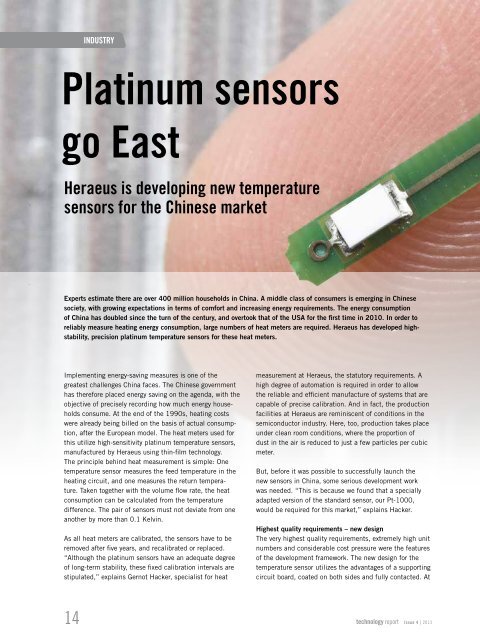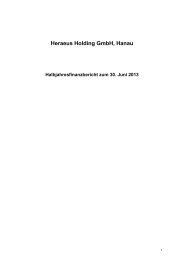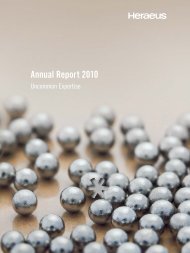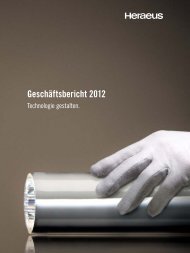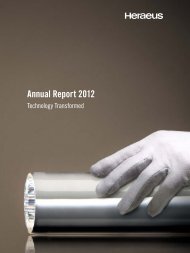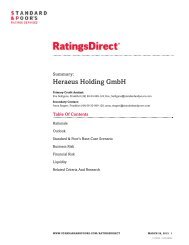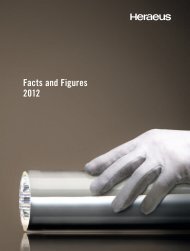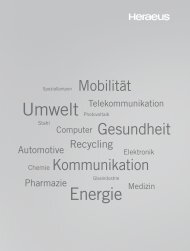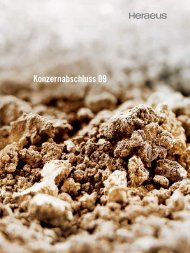technology report 04
technology report 04
technology report 04
Create successful ePaper yourself
Turn your PDF publications into a flip-book with our unique Google optimized e-Paper software.
Industry<br />
Platinum sensors<br />
go East<br />
Heraeus is developing new temperature<br />
sensors for the Chinese market<br />
Experts estimate there are over 400 million households in China. A middle class of consumers is emerging in Chinese<br />
society, with growing expectations in terms of comfort and increasing energy requirements. The energy consumption<br />
of China has doubled since the turn of the century, and overtook that of the USA for the first time in 2010. In order to<br />
reliably measure heating energy consumption, large numbers of heat meters are required. Heraeus has developed highstability,<br />
precision platinum temperature sensors for these heat meters.<br />
Implementing energy-saving measures is one of the<br />
greatest challenges China faces. The Chinese government<br />
has therefore placed energy saving on the agenda, with the<br />
objective of precisely recording how much energy households<br />
consume. At the end of the 1990s, heating costs<br />
were already being billed on the basis of actual consumption,<br />
after the European model. The heat meters used for<br />
this utilize high-sensitivity platinum temperature sensors,<br />
manufactured by Heraeus using thin-film <strong>technology</strong>.<br />
The principle behind heat measurement is simple: One<br />
temperature sensor measures the feed temperature in the<br />
heating circuit, and one measures the return temperature.<br />
Taken together with the volume flow rate, the heat<br />
consumption can be calculated from the temperature<br />
difference. The pair of sensors must not deviate from one<br />
another by more than 0.1 Kelvin.<br />
As all heat meters are calibrated, the sensors have to be<br />
removed after five years, and recalibrated or replaced.<br />
“Although the platinum sensors have an adequate degree<br />
of long-term stability, these fixed calibration intervals are<br />
stipulated,” explains Gernot Hacker, specialist for heat<br />
measurement at Heraeus, the statutory requirements. A<br />
high degree of automation is required in order to allow<br />
the reliable and efficient manufacture of systems that are<br />
capable of precise calibration. And in fact, the production<br />
facilities at Heraeus are reminiscent of conditions in the<br />
semiconductor industry. Here, too, production takes place<br />
under clean room conditions, where the proportion of<br />
dust in the air is reduced to just a few particles per cubic<br />
meter.<br />
But, before it was possible to successfully launch the<br />
new sensors in China, some serious development work<br />
was needed. “This is because we found that a specially<br />
adapted version of the standard sensor, our Pt-1000,<br />
would be required for this market,” explains Hacker.<br />
Highest quality requirements – new design<br />
The very highest quality requirements, extremely high unit<br />
numbers and considerable cost pressure were the features<br />
of the development framework. The new design for the<br />
temperature sensor utilizes the advantages of a supporting<br />
circuit board, coated on both sides and fully contacted. At<br />
14 <strong>technology</strong> <strong>report</strong> Issue 4 | 2013


